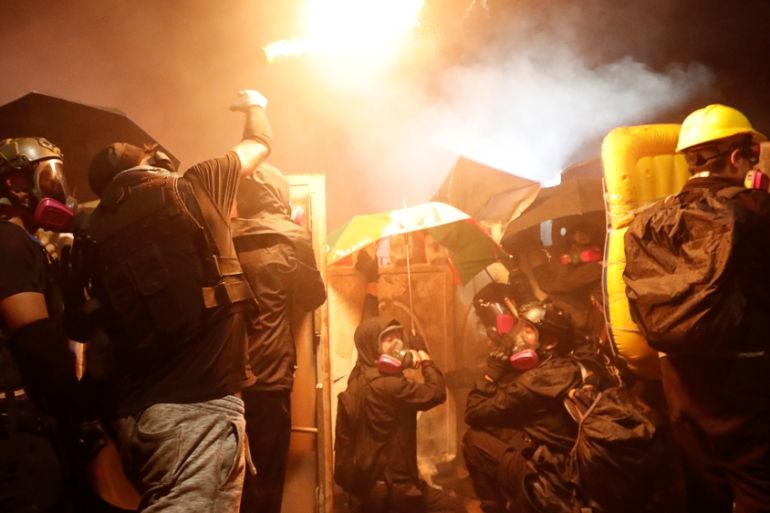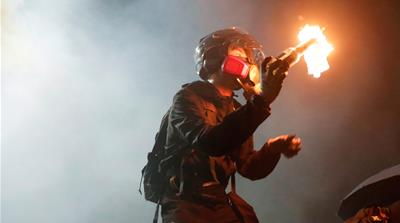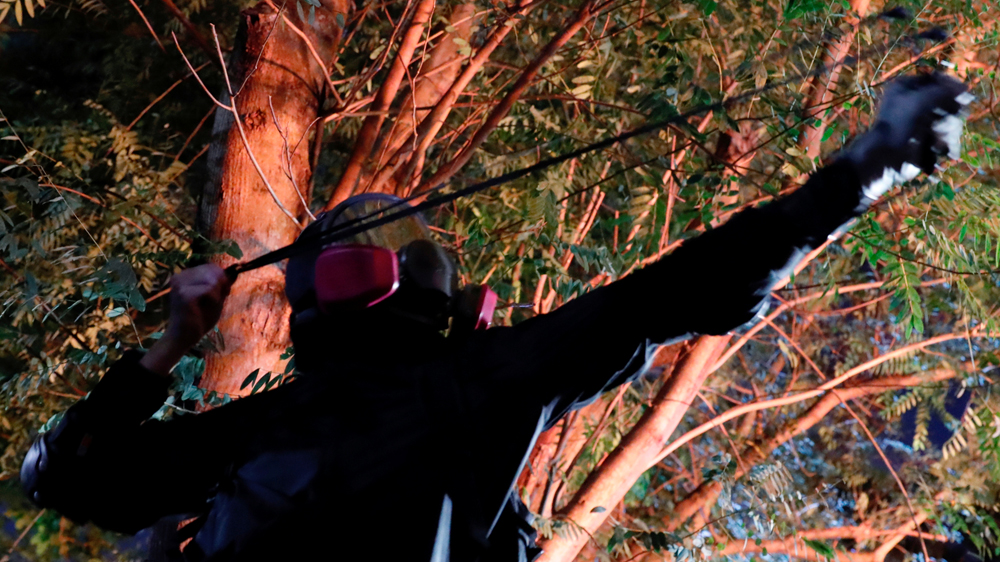Violence brings Hong Kong to ‘brink of total breakdown’: Police
Hong Kong police say masked ‘rioters’ committed ‘insane’ acts of vandalism that paralysed the city’s transport system.

Fierce fighting between riot police and Hong Kong protesters raged into the night at a major university as months-long anti-government demonstrations continued to take a violent turn for the worse on Tuesday.
Streets inside and outside the Chinese University of Hong Kong campus entrance were littered with bricks, other debris, and street fires as police tackled some protesters to the ground. A van used as part of a street barricade was set ablaze.
Keep reading
list of 4 itemsThe Take: Where are Hong Kong’s protesters now?
Hong Kong’s new security law comes into force amid human rights concerns
Hong Kong passes tough new national security law
“Going late into the night, it seems there is so much anger on both sides,” said Al Jazeera’s Divya Gopalan, reporting from Hong Kong.
“Police are firing water cannon while students are standing their ground, putting out calls on social media asking for reinforcements for more support. It seems like the stand-off will continue at the Chinese University.”
Hong Kong police earlier fired tear gas in Central, the financial district, over the harbour in Mong Kok and at universities to break up pro-democracy protests they said were leading the city to the “brink of total breakdown”.
The chaotic night scenes of explosions, smoke plumes, yelling and sustained gunfire, which left scores of injured students sprawled on the ground, stoked a sense of dread among some who recalled the 1989 Tiananmen Square crackdown by Chinese troops on pro-democracy protesters in Beijing.
“The fear among the students is so strong,” said Wing Long, a 25-year-old theology student. “That’s why we’ve gathered today to stop it from happening.”
Medics on the scene said at least 60 people were injured.
The European Union called on all sides involved in the violence to show restraint.
“The far-reaching impact of the situation on lives and livelihoods in the territory makes a credible and swift solution to the unrest imperative,” EU spokeswoman Maja Kocijancic said in a statement.

Deadly attacks
The clashes came a day after police shot a protester at close range and a man was doused with petrol and set on fire in some of the worst violence in the self-governing territory in decades.
A flash mob of more than 1,000 protesters, many wearing office clothes and face masks, rallied in Central for a second day during lunch hour, blocking roads below some of the city’s tallest skyscrapers and most expensive real estate.
|
|
After they had dispersed, police fired tear gas at the remaining protesters on old, narrow Pedder Street. Police made more than a dozen arrests, many pinned up on the pavement against the wall of luxury jeweller Tiffany & Co.
“Our society has been pushed to the brink of a total breakdown,” a police spokesman told a briefing, referring to the last two days of violence in the former British colony.
He said masked “rioters” had committed “insane” acts, such as throwing rubbish, bicycles and other debris onto metro tracks and overhead power lines, paralysing the transport system.
He said the man set on fire on Monday was still in critical condition and appealed for information on who was responsible.
Police also fired tear gas at City University in Kowloon Tong, beneath the Lion Rock, where protesters threw petrol bombs and bricks at police.
Protesters at City University had stockpiled bricks and petrol bombs on the bridges and other approaches and were making small devices with nails. They had overrun the campus and were smashing up the next-door Festival Walk shopping mall and setting fires.
‘It’s our school’
The students were taking part in a heated late-night exchange with the principal when clashes reignited, with police again firing volleys of tear gas and protesters throwing petrol bombs, lighting up the sky.
“It’s crazy that police have been firing tear gas for more than 20 minutes. If they didn’t come in, we wouldn’t clash with them. It’s our school. We need to protect our home,” said Candy, a 20-year-old student.
Several people were wounded, including a student reporter who was hit in the eye, apparently by a brick, and was seen sitting in tears as friends offered comfort.
|
|
Police also fired tear gas in the nearby new town of Tai Po and in the densely populated Kowloon district of Mong Kok, whose shopping artery Nathan Road has been the scene of many clashes.
Hong Kong leader Carrie Lam said protesters were being extremely selfish and hoped that universities and schools would urge students not to take part in the demonstrations.
More than 260 people were arrested on Monday, police said, bringing the total number to more than 3,000 since the protests escalated in June. Schools and universities said they would close again on Tuesday.
Protesters are angry about what they see as police brutality and meddling by Beijing in the freedoms guaranteed under the “one country, two systems” formula put in place when the territory was returned to China from British rule in 1997.

China denies interfering and has blamed Western countries including the United Kingdom and the United States for stirring up trouble.
The US on Monday condemned “unjustified use of deadly force” in Hong Kong and urged police and civilians alike to de-escalate the situation.
The spokesman for the Ministry of Foreign Affairs of the People’s Republic of China, Geng Shuang, urged the UK and the US not to intrude.
“Hong Kong affairs are purely China’s internal affairs that allow no foreign interference. We urge the United States, United Kingdom and other countries to earnestly respect China’s sovereignty.”
China has a garrison of up to 12,000 troops in Hong Kong who have kept to barracks since 1997 but it has promised to crush any attempts at independence, a demand for a small minority of protesters.
Geng also told a briefing in Beijing that China’s government firmly supports Lam’s administration and the Hong Kong police “in law enforcement, maintaining social order and protecting the safety of citizens”.
|
|